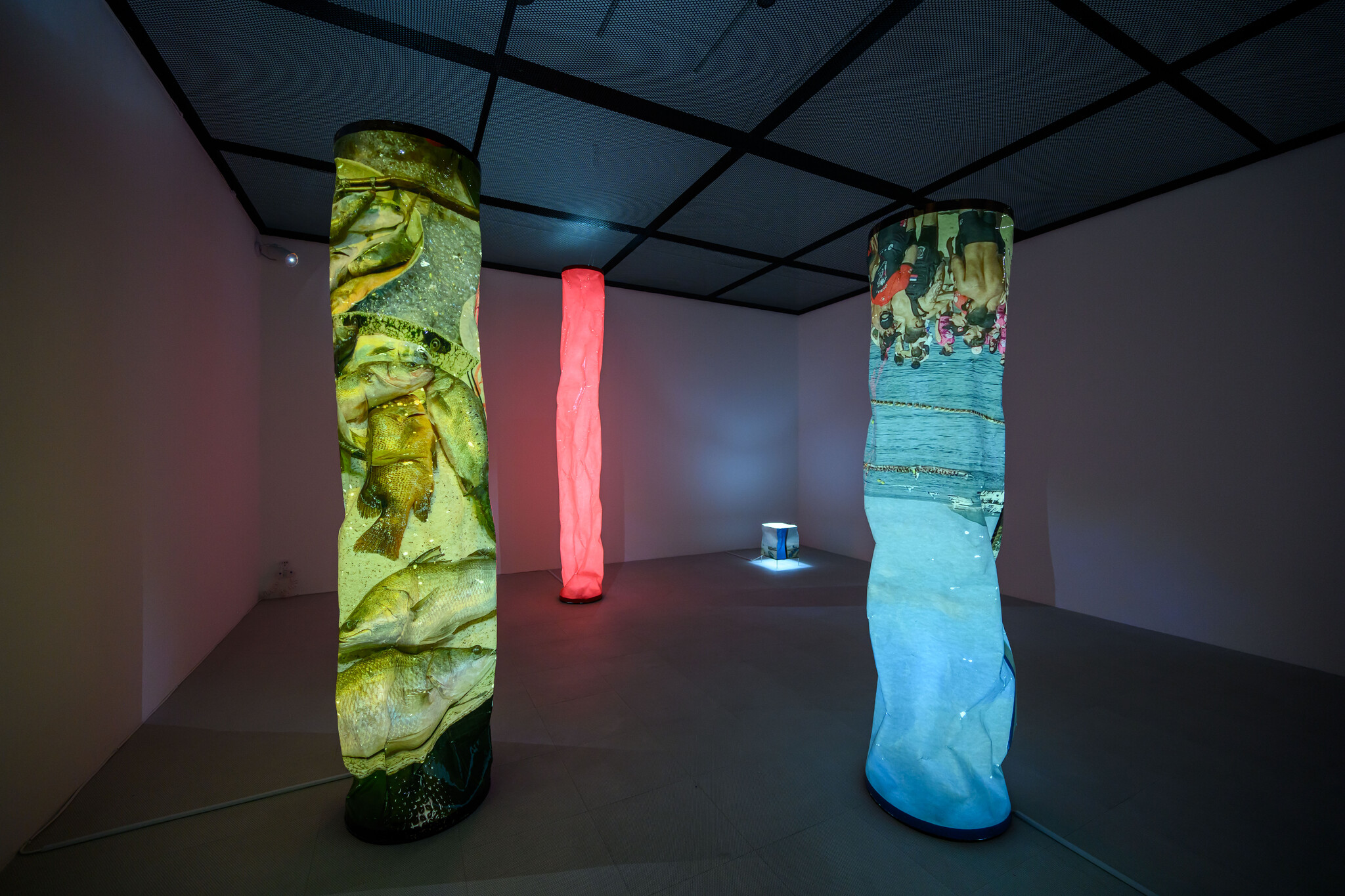Shows
Nabuqi’s “Geopoetics regarding a waterless sea”

Nabuqi
Geopoetics regarding a waterless seaKiang Malingue
Hong Kong
Sep 12–Oct 12
In his 1936 essay “The Storyteller,” Walter Benjamin lamented the loss of what he termed the “artisan form of communication.” Passed down through generations, stories once served as vessels for shared experiences and collective wisdom. But this slow, layered communication of lived experience has since been replaced by the immediacy of information.
From crafting fluid sculptural forms to constructing psychologically charged spaces, the Inner Mongolia-born, Beijing-based artist Nabuqi is known for her explorations into the physical and psychological aspects of perceiving objects in their natural surroundings. The artist’s latest exhibition at Hong Kong’s Kiang Malingue gallery, “Geopoetics regarding a waterless sea” (the title of which is based on a newly commissioned short story by Chen Si’an in 2024), presented a new body of sculptures and installations that recall the tradition of storytelling as an action that unfolds over time through both texture and nuance.
As Benjamin described it, the traditional storyteller not only conveys events but weaves them into the fabric of memory. The joy lies not in the relaying of facts but in the transpiring of events that evoke emotions and interpretations. Paradoxically, then, narrators who strive to convey events factually are the ones who disrupt the “game” of storytelling. This dichotomy between function and playfulness is at the heart of Nabuqi’s new series How do humans obtain from the sea things that it does not possess (2024), which comprises six slender, key-like sculptures, each adorned with a curious assortment of objects—from marine fragments to miniature vehicles and photographic details. From a distance, the minimal forms made in metal are reminiscent of the Bauhaus praxis of a functional aesthetic. But Nabuqi’s rod-like sculptures depart from that point radically, instead emphasizing the organic interplay of the components and the theatricality of novel forms. For instance, in No. 1, four bronze crab legs are fastened to the end of the rod, a humorous gesture toward movement or escape. Another work, No. 6, features a single bronze-cast crab claw incongruously placed at one end, evoking a sense of quiet absurdity. While these assemblages seem to mock the idea of function, they also suggest an indefinite narrative: the disembodied parts speak to the futility of seeking what cannot be possessed, and the tiny square photographic snippets depicting Hong Kong, interspersed with the organic forms on the rods, echo Chen Si’an’s tale of displacement—a re-imagination of humans and nonhumans as they flee from land or sea.

NABUQI, How do humans obtain from the sea things that it does not possess No.1, 2024, bronze, brass, 100 × 8 × 3 cm. Courtesy the artist and Kiang Malingue, Hong Kong.

NABUQI, How do humans obtain from the sea things that it does not possess No.6, 2024, bronze, brass, 55 × 10 × 4 cm. Courtesy the artist and Kiang Malingue, Hong Kong.
Nabuqi’s exploration of found images plays a significant role in Fish finding a path ashore (2024), a series of four irregular cylindrical forms layered with photographs captured in Hong Kong. Together they create a playful scale difference: only one of the three exceeds two meters in height, while the smallest is less than 40 centimeters in height. Encased in resin, the Hong Kong-related images of Victoria Park, a fish tank, a beach, and the statue of Queen Victoria—some rendered almost unrecognizable through distortion—are folded into the sculptures, enlarged, pixelated and displayed vertically around the surface, as if these everyday scenes have been plucked from their original contexts and suspended in time. As such the series was presented as a constellation of private and public spaces that invited viewers to make up their own narrative and perception of these sites.
In Chen’s novel, an enigmatic figure works endlessly to craft an esoteric map—one that charts the imperceptible geographic changes across millennia. Nabuqi’s response to this character takes form in Geo-cataloguer (2024), a cast aluminum sculpture resembling a silver table and remarkably thin at just three to five millimeters. The sculpture translates the cryptic map into physical form and its surface, as Nabuqi wrote, is “fragile and manifold, in which one casually becomes another without the possibility of definition.” The work presents a space where one state of being seamlessly transitions into another. In its delicate materiality, the sculpture provides a meditation on presence and impermanence, the bodily and the unearthly.
The exhibition follows Chen’s narrative trajectories of metamorphosis and displacement—from aquatic beings yearning for life ashore to the historic exodus of the Tanka people, an ethnic subgroup in southern China. Inspired by Chen’s story of the last Tanka, who embody the poetic characterization of “roaming between heaven and earth,” Nabuqi’s sculptural response, It (2024), displayed on the rooftop, is a ring-like structure supported by rods with a mass of bronze appearing to melt into a soft, mud-like shape, as though it once held a solid form but has since dissolved. The interplay of sturdiness and malleability reflects on the paradox of a community grounded in history yet perpetually in motion, living between worlds. Within the exhibition, Nabuqi envisions a world where human and nonhuman beings alike are caught in constant states of flux, navigating the shifting boundaries between land and sea, memory and place.
Louis Lu is associate editor at ArtAsiaPacific.







